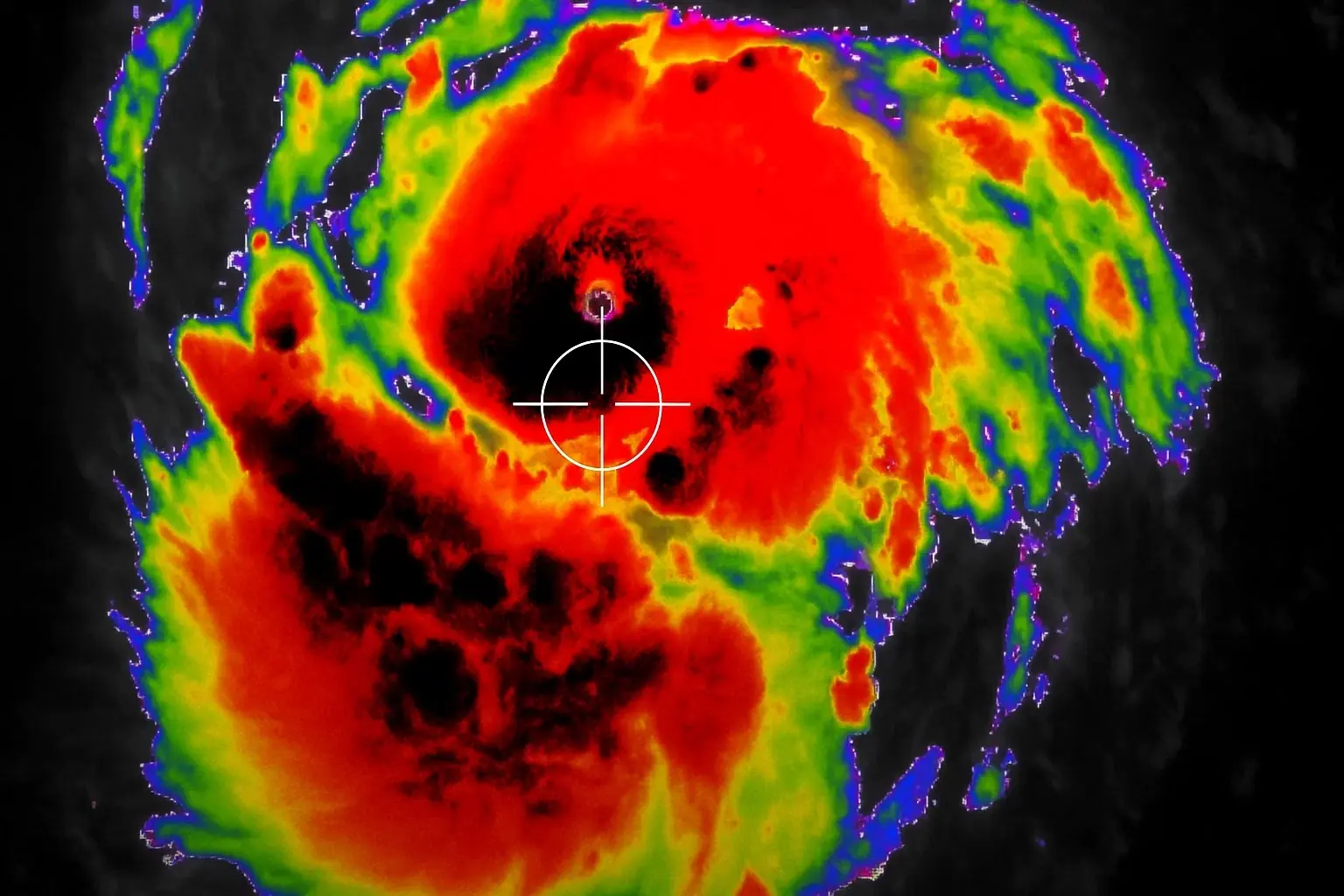
URGENT WARNING: Hurricane Erin Strengthens to Rare Category 5 With ‘Catastrophic Damage’ Threat
Hurricane season has officially arrived—and this year it’s showing no mercy. Meteorologists are sounding alarms as Hurricane Erin barrels through the Atlantic, reaching extreme strength and posing a devastating threat to parts of the United States and beyond.
Hurricane Season in Full Force
The Atlantic hurricane season runs annually from June 1 through November 30, a stretch of months when storms often form and grow in intensity. While residents along the Gulf Coast and the Eastern Seaboard are familiar with hurricane threats, experts stress that 2025 is shaping up to be an above-average year. According to forecasts, the number of named storms is expected to exceed historic records, with the National Oceanic and Atmospheric Administration (NOAA) predicting between 13 to 19 named systems this season alone.
Among them, Hurricane Erin has already made history.

How Erin Grew So Powerful
Initially detected as a Category 1 storm with wind speeds of about 75 mph, Erin rapidly intensified in just 24 hours—an event meteorologists call rapid intensification. According to CNN, the storm jumped from a weaker Category 1 to a rare and dangerous Category 5 hurricane, joining the ranks of only 43 Category 5 hurricanes ever recorded in the Atlantic.
The National Weather Service describes Category 5 storms as those with wind speeds exceeding 130 to 150 mph, capable of unleashing catastrophic destruction.
"Well-built framed homes can sustain severe damage with loss of most of the roof structure and/or some exterior walls," the agency warns.
The damage doesn’t stop there. Most trees are expected to be snapped or uprooted, while power lines and poles are likely to be torn down. This means entire communities could be left isolated without electricity for weeks, or even months, leaving large areas uninhabitable.
Urgent Warnings from Experts
Given Erin’s strength, the National Hurricane Center (NHC) issued an urgent public warning on Saturday, August 16, stressing the storm’s wide-reaching impact:
"Erin is expected to produce life-threatening surf and rip currents along the beaches of the Bahamas, much of the east coast of the US, and Atlantic Canada next week."
AccuWeather’s Lead Hurricane Expert, Alex DaSilva, expanded on the risks:
"Erin is forecast to slowly curve to the north as it continues to strengthen over the weekend. At this time, the storm is forecast to remain hundreds of miles off the East Coast," DaSilva noted.
Despite not making immediate landfall, he warned that rough surf and dangerous rip currents are expected across the entire East Coast—from Florida to New England and into Atlantic Canada—as Erin tracks north and eventually northeast.
Particularly vulnerable coastal areas include:
- North Carolina’s Outer Banks
- Long Island, New York
- Cape Cod, Massachusetts
These regions are considered “protruding” areas, where the ocean’s force hits with greater strength, putting communities at higher risk.
Fluctuating Intensity
By early Sunday morning (August 17), Hurricane Erin had temporarily weakened to a Category 3 storm. However, meteorologists caution that this is not the end of its danger. CNN reports that Erin is forecast to reintensify into a Category 5 storm, underscoring the unpredictable and volatile nature of hurricanes in warm Atlantic waters.
More Storms on the Horizon
Unfortunately, Erin isn’t the only system to watch. This year’s hurricane season has already been described as “above average” in activity. With NOAA predicting a surge in storm formation, experts are preparing the public for multiple severe weather events in the months ahead.
Communities across the eastern United States, the Caribbean, and even parts of Atlantic Canada are urged to monitor weather updates daily, secure emergency supplies, and prepare evacuation plans if needed.
Final Thoughts
Hurricane Erin has already secured its place in the history books as one of the rare Category 5 storms in the Atlantic. While the storm’s exact track remains uncertain, its potential for catastrophic damage cannot be underestimated. Experts urge residents in vulnerable regions to remain vigilant, take official warnings seriously, and prioritize safety above all else.
With the 2025 hurricane season predicted to be unusually active, Erin may only be the beginning of a long and dangerous few months ahead.
News in the same category


Why should you keep some money behind your phone case?

Choose a Ring and Discover Your Deepest Personality Trait
Jewelry is more than just an accessory—it’s a reflection of who we are. The rings we choose can reveal not only our fashion sense, but also our emotions, values, and even the deepest aspects of our character.

If You Notice A Man With One Painted Nail, This Is What It Actually Means
The Powerful Meaning Behind One Painted Nail—A Global Movement You Should Know About

Rare Black Moon Phenomenon Will Darken the Skies This August—Astronomers Say You Can’t Miss It
The August Black Moon provides an opportunity to step outside, look up, and reconnect with the rhythms of the universe.

Why do hotels always have a cloth across the bed?

15 Things You Should Never Plug Into A Power Strip

The HEALTHIEST FRUIT on Earth: what happens to your body if you eat just 3 a day...

Add This To The Water Your Floors Will Remain Clean For Weeks
With just a few simple ingredients you likely already have at home, you can transform your cleaning routine and enjoy a healthier, cleaner living space

Sensitive new details revealed after government papers were left behind at Trump-Putin meeting

Grok brutally calls Elon Musk a 'hypocrite' after ChatGPT CEO goes to war with Tesla billionaire

Police recover $30,000 worth of stolen Labubus from California home in bizarre heist

Here’s Why You Should Stop Storing Milk in the Refrigerator Door

Reasons Why Dogs Smell Your Crotch

What Your Palm Lines Say About Love and Marriage

Never Ever Say These 4 Things at a Funeral — No Matter the Situation
When it comes to funerals and expressions of sympathy, your words don’t need to be profound or poetic.

The Hidden Meaning Behind Leg-crossing — It’s More Than Just Comfort

How To Properly Dispose of Ticks

Why Do You Keep Waking Up Between 3 and 5 A.M.? Causes, Explanations, and What It Means for Your Health
News Post

lacing these 3 things on top of the fridge will cause wealth to disappear, no matter how much you have.

Buying bananas: Wise people turn away when they see these 3 types, while foolish ones grab them just because they’re cheap

Don’t soak frozen meat in plain water. According to chefs, there’s a way to defrost it in just 5 minutes while keeping it delicious.

Water heaters have a hidden 'switch.' Any household that knows how to open it can use it for 10 years without worrying about damage or high electricity bills

Mix white salt with fabric softener, solve many household problems, and save a lot of money.

Apply this on a knife, and no matter how dull it is, it will become razor-sharp and shiny, without needing a whetstone.

Inside the washing machine, there’s a ‘small box’ with an incredibly powerful function: Not knowing how to use it is such a waste.

Why Some Women Lose Their Desire: 4 Avenues to Explore

Why should you keep some money behind your phone case?

If You Have Colon Polyps, These 4 Signs While Using the Toilet May Appear – See a Doctor Before It’s Too Late

From age 65, how often should you shower (and why over-washing can be harmful to your health)

What’s the Secret to Becoming a Super-Ager?

Coffee, Cookies, and Cheese Recalled From Major Retailers in Multiple States

H. Pylori Fears These 5 Foods the Most — Eat Them to Protect Your Stomach

Woman Unveils 5 Colon Cancer Symptoms You Must Never Ignore
Colon cancer is often called the “silent disease” because its warning signs are easy to dismiss. One Texas mother, Radwah Oda, is now sharing her painful journey in hopes of saving others from making the same mistake.

The Silent Killer" That Causes Brain Shrinkage — Yet Parents Still Feed It to Their Children Daily

Mother and Child D:ie From Liver Cancer — Doctors Reveal 3 Ingredients That Should Never Go Into Porridge
The story of the mother and child stands as a haunting reminder that the smallest choices in the kitchen can carry lifelong consequences.

Proven Health Benefits of Walnuts, How Many to Eat, and More (Science Based)

The Most Dangerous Foods: Unpacking the Risks of Processed Meat
